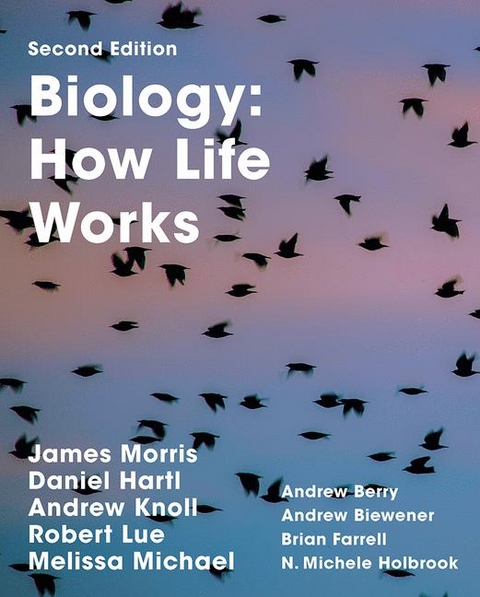
Biology: How Life Works, Volume 1
W.H.Freeman & Co Ltd (Verlag)
978-1-319-04882-2 (ISBN)
- Titel ist leider vergriffen;
keine Neuauflage - Artikel merken
Content is selected carefully, is integrated to illustrate the connections between concepts, and follows six themes that are crucial to biology: the scientific method, chemical and physical processes, cells, evolution, ecological interactions, and human impact.
The second edition continues this approach, but includes expanded coverage of ecology, new in-class activities to assist instructors in active teaching, new pedagogical support for visual synthesis maps, and expanded and improved assessment.
James Morris - Professor of Biology at Brandeis University. He teaches a wide variety of courses for majors and non-majors, including introductory biology, evolution, genetics and genomics, epigenetics, comparative vertebrate anatomy, and a first-year seminar on Darwin’s On the Origin of Species. He is the recipient of numerous teaching awards from Brandeis and Harvard. His research focuses on the rapidly growing field of epigenetics, making use of the fruit fly Drosophila melanogaster as a model organism. Daniel Hartl - Higgins Professor of Biology in the Department of Organismic and Evolutionary Biology at Harvard University and Professor of Immunology and Infectious Diseases at the Harvard Chan School of Public Health. He has taught highly popular courses in genetics and evolution at both the introductory and advanced levels. His lab studies molecular evolutionary genetics and population genetics and genomics. Dr. Hartl is the recipient of the Samuel Weiner Outstanding Scholar Award as well as the Gold Medal of the Stazione Zoologica Anton Dohrn, Naples. Andrew Knoll - Fisher Professor of Natural History in the Department of Organismic and Evolutionary Biology at Harvard University. He is also Professor of Earth and Planetary Sciences. Dr. Knoll teaches introductory courses in both departments. His research focuses on the early evolution of life, Precambrian environmental history, and the interconnections between the two. He has also worked extensively on the early evolution of animals, mass extinction, and plant evolution. Robert Lue - Professor of Molecular and Cellular Biology at Harvard University and the Richard L. Menschel Faculty Director of the Derek Bok Center for Teaching and Learning. Dr. Lue has a longstanding commitment to interdisciplinary teaching and research, and chaired the faculty committee that developed the first integratedscience foundation in the country to serve science majors as well as pre-medical students. Melissa Michael - Director for Core Curriculum and Assistant Director for Undergraduate Instruction for the School of Molecular and Cellular Biology at the University of Illinois at Urbana-Champaign. A cell biologist, she primarily focuses on the continuing development of the School’s undergraduate curricula. Andrew Berry - Lecturer in the Department of Organismic and Evolutionary Biology and an undergraduate advisor in the Life Sciences at Harvard University. With research interests in evolutionary biology and history of science, he teaches courses that either focus on one of the areas or combine the two. Andrew Biewener - Charles P. Lyman Professor of Biology in the Department of Organismic and Evolutionary Biology at Harvard University and Director of the Concord Field Station. He teaches both introductory and advanced courses in anatomy, physiology, and biomechanics. Brian D. Farrell - Director of the David Rockefeller Center for Latin American Studies and Professor of Organismic and Evolutionary Biology and Curator in Entomology at the Museum of Comparative Zoology at Harvard University. He is an authority on coevolution between insects and plants and a specialist on the biology of beetles. N. Michele Holbrook -
1. Life: Chemical, Cellular, and Evolutionary FoundationsCase.- 1 The First Cell: Life’s Origins.- 2. The Molecules of LifeNew coverage of functional groups.- 3. Nucleic Acids and TranscriptionNucleotides now shown at physiological pH.- 4. Translation and Protein StructureAmino acids now shown at physiological pH.- 5. Organizing Principles: Lipids, Membranes, and Cell Compartments.- 6. Making Life Work: Capturing and Using Energy.- 7. Cellular Respiration: Harvesting Energy from Carbohydrates and Other Fuel Molecules.- 8. Photosynthesis: Using Sunlight to Build CarbohydratesThe story of the evolution of photosynthesis now brought together in a single major section at the end of the chapter (Section 8.5). Case 2: Cancer: When Good Cells Go Bad.- 9. Cell Signaling.- 10. Cell and Tissue Architecture: Cytoskeleton, Cell Junctions, and Extracellular MatrixChapters 9 and 10 have been streamlined to better match our mission statement.- 11. Cell Division: Variations, Regulation, and CancerCase 3 You, From A to T: Your Personal Genome.- 12. DNA Replication and ManipulationNew inclusion of the trombone model of DNA replicationAddition of CRISPR technology.- 13. GenomesExpanded coverage of retrotransposons and reverse transcriptase.- 14. Mutation and DNA Repair.- 15. Genetic Variation.- 16. Mendelian InheritanceA new How Do We Know? figure explaining Mendel’s experimental results.- 17. Inheritance of Sex Chromosomes, Linked Genes, and Organelles.- 18. The Genetic and Environmental Basis of Complex Traits.- 19. Genetic and Epigenetic Regulation New discussion of the mechanism of X-inactivation.- 20. Genes and DevelopmentCase 4 Malaria: Coevolution of Humans and a Parasite.- 21. Evolution: How Genotypes and Phenotypes Change Over TimeAn expanded discussion of nonrandom mating and inbreeding depression.- 22. Species and Speciation.- 23. Evolutionary Patterns: Phylogeny and FossilsAddition of the effect of mass extinctions on species diversity.- 24. Human Origins and EvolutionUpdated discussion of the relationship between Neanderthals and Homo sapiens, as well as Denisovans.
| Erscheinungsdatum | 22.01.2016 |
|---|---|
| Zusatzinfo | 800 p. |
| Sprache | englisch |
| Themenwelt | Naturwissenschaften ► Biologie ► Allgemeines / Lexika |
| ISBN-10 | 1-319-04882-X / 131904882X |
| ISBN-13 | 978-1-319-04882-2 / 9781319048822 |
| Zustand | Neuware |
| Haben Sie eine Frage zum Produkt? |
aus dem Bereich


